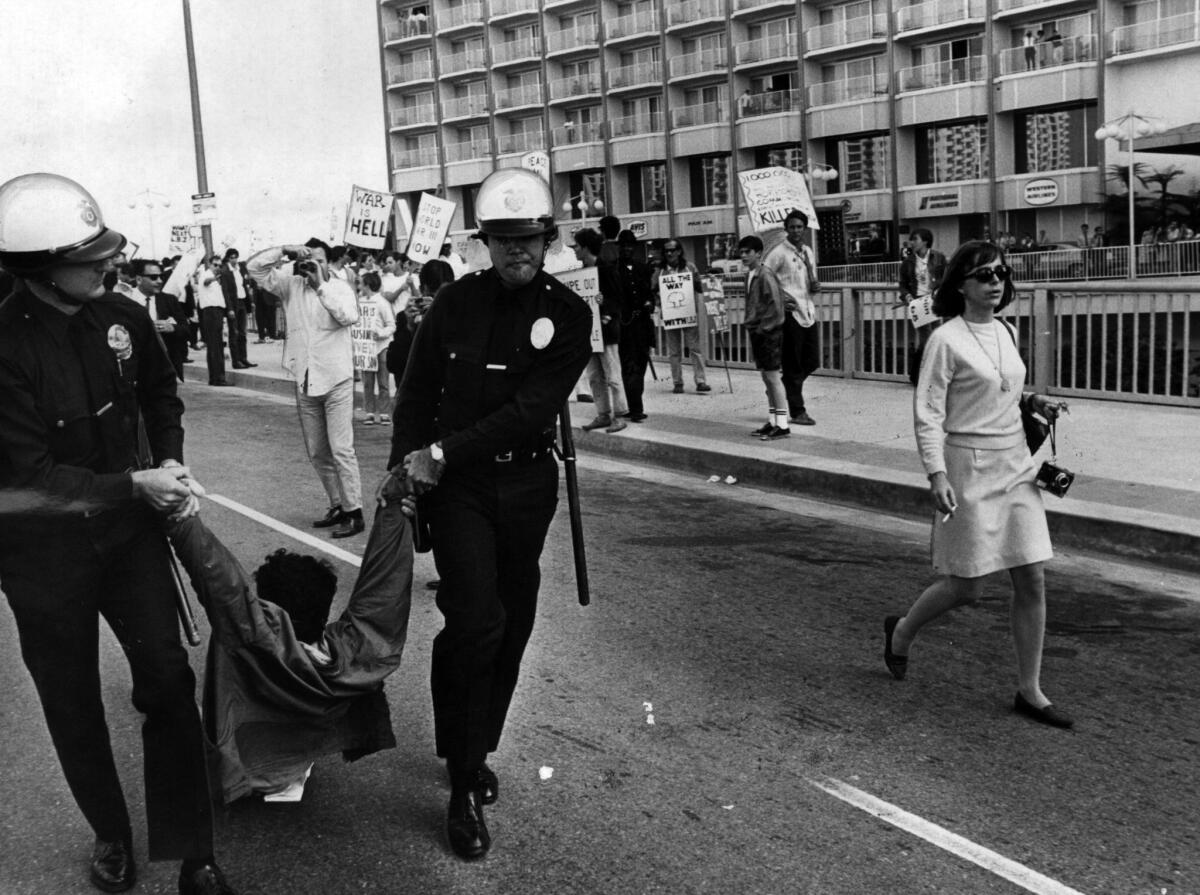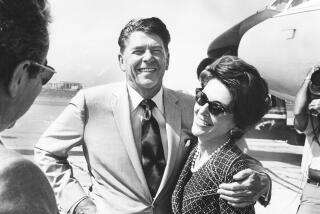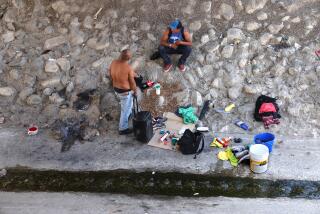Amid an era rife with rebellion, the Watts riots were a wake-up call

In 1967, LAPD officers remove a protester from the Century Plaza Hotel during an anti-Vietnam War demonstration where Democrats had gathered to hear President Lyndon Johnson.
It was a time in California of turmoil and confusion — of revolution and revulsion. And anger, fueling unprecedented mass violence.
A lot of half-century ruminating has been going on and, being on vacation, I’ve missed out. So I’m catching up.
The Watts riots have been analyzed from every angle, but many other historic events were happening 50 years ago or thereabouts in this state.
Campus protests, especially over the escalating Vietnam War, were polarizing the public.
California enacted the state’s first healthcare program for the poor.
The Legislature was moving toward a dramatic remaking of itself, the most significant since statehood.
Liberal Democrats were starting to lose their iron grip on California politics as Republicans began to regain some of the power they’d held for practically the whole century until Pat Brown — Jerry’s father — pummeled the imploding GOP in 1958. The new Republican Party, however, was emerging as much more conservative.
As for Watts, it was a wake-up call for California, a loud signal that we were not so blissfully above all the racial unrest tearing apart other regions of the country, mainly the South, as had been smugly thought.
Only the year before, after all, Californians had voted nearly 2 to 1 to continue racial discrimination in housing, repealing an anti-bias bill passed by the Democratic-controlled Legislature and pushed by Gov. Pat Brown. People in Watts undoubtedly saw that as white voters’ middle finger.
Add to that the routine Los Angeles police harassment and job discrimination, plus TV footage of the southern Bull Connors and fire hoses, and the riots shouldn’t have been the shock to California that they were.
The torching and looting left 34 dead and thousands injured. But Watts didn’t trigger other happenings — including political — as much as it was one piece of a mosaic taking shape throughout the country and state. People everywhere were rebelling.
Already, there was a budding revolt against liberalism, especially as practiced in Sacramento.
The year before, conservative Republican Barry Goldwater had defeated moderate Nelson Rockefeller in the decisive California primary to win the presidential nomination. A conservative song-and-dance man, Republican George Murphy, had captured a Democratic U.S. Senate seat. And right-wingers seized the state GOP from moderates.
Ronald Reagan, an outspoken Goldwater booster, naturally followed into the governorship in 1966, trouncing moderate former San Francisco Mayor George Christopher for the party nomination, then dumping Brown in a landslide.
Fifty years ago, voters were looking to the right, while Democratic politicians kept marching left.
In Sacramento, Brown and the Legislature quickly took advantage of President Johnson’s newly enacted Medicaid program for the poor and created their own version, naming it Medi-Cal. That furthered the state’s generous expansion of welfare. Today, nearly one-third of California residents are covered by financially troubled Medi-Cal.
Meanwhile, leftist activists were rebelling against the rapidly expanding Vietnam War. Young men were being drafted to go off and die for a questionable cause.
The UC Berkeley Free Speech Movement and antiwar protests soon spread to other university campuses, triggering mass student violence and angering voters, especially those not having been privileged to attend college themselves. Reagan was their voice.
In 1965, the Legislature was bowing reluctantly — the Senate was, at least — to a shocking order from the U.S. Supreme Court, headed by former California Gov. Earl Warren. It would have to redistrict the Senate on the basis of “one man, one vote” (no gender neutral pronouns back then).
State senators no longer could be elected on the basis of geography, as they are in Congress. Legislators all needed to be chosen based on population. “Legislators represent people, not trees or acres,” Warren wrote.
Southern California firmly took over the Legislature. Before that, L.A. had only one senator. Afterward, starting in 1967, it had 14. Unfortunately, California lost a lot of knowledgeable, practical lawmakers.
At the same time, the Legislature proposed and the voters in 1966 approved a measure upgrading it from a part-time to a full-time operation. On the whole, it was a good thing and necessary for a rapidly growing state.
A half century ago, California’s population was 18.6 million. Today, it’s more than double that, nearly 39 million.
More significant politically has been the demographic upheaval. Whites dominated the population half a century ago. Now they’re surpassed by Latinos, who have fled the GOP because of its anti-illegal immigration jabbering. Social issues — abortion, gay rights — also have buried Republican politicians in California.
For most of us, life is more tranquil and less threatening today than half a century ago. In some ways it’s a recycling of the ‘50s. Yes, there’s a larger wage gap and a declining middle class. But school kids don’t practice nuclear fallout drills or riot when they get to college.
Fifty years ago, everyone seemed mad at one another. Today, they’re just cynical.
[email protected]
Twitter: @LATimesSkelton
More to Read
Sign up for Essential California
The most important California stories and recommendations in your inbox every morning.
You may occasionally receive promotional content from the Los Angeles Times.











